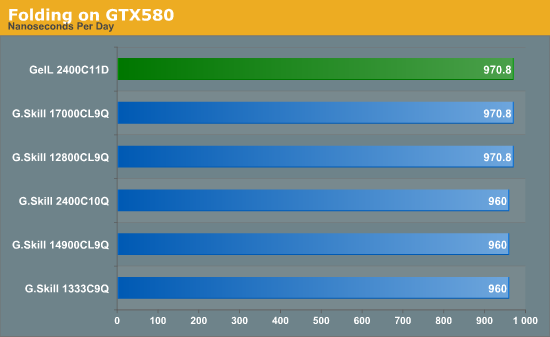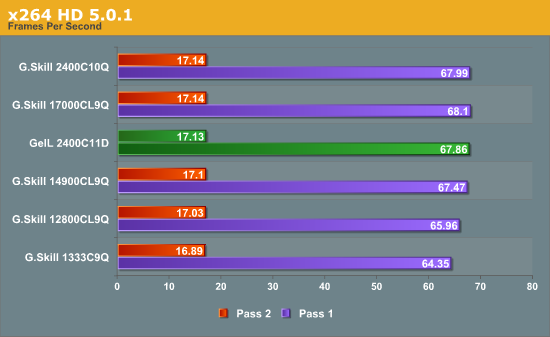GeIL Evo Veloce Review: 2x8GB at DDR3-2400 C11-12-12 1.65 V
by Ian Cutress on October 24, 2012 5:50 PM EST- Posted in
- Memory
- Ivy Bridge
- DDR3
- GeIL
Conversion – Xilisoft 7
Another classic example of memory bandwidth and speed is during video conversion. Data is passed between the memory and the CPU for processing – ideally faster memory here helps as well as memory that can deal with consecutive reads. Multiple threads on the CPU will also provide an additional stress, as each will ask for different data from the system. If we combine this with the capability of using GPUs that Xilisoft Video Converter 7 allows, we can attempt to really tax the memory. Our test consists of converting 26GB of various sized videos (1080p to VGA), totalling 45+ hours of video time, to MP2 format using our test bed.


No surprising results from our Xilisoft testing.
Folding on GPU
Memory usage is all algorithm dependent – if the calculation has a lot of small loops that do not require additional reads memory, then memory is unimportant. If the calculation requires data from other sources in those calculations, then memory can either be stressed randomly or sequentially. Using Ryan’s Folding benchmark as a platform, we are testing how much memory affects the serial calculation part of a standard F@H work unit. Unfortunately this test is to the nearest second, but we convert the time taken into nanoseconds per day for the graph.

As confirmed in our round up, memory speed (or module size, moving from 4GB to 8GB) has no appreciable effect on folding.
WinRAR x64 4.20
When compressing or converting files from one format to another, the file itself is often held in memory then passed through the CPU to be processed, then written back. If the file is larger than the available memory, then there is also loading time between the storage and the memory to consider. WinRAR is a variable multi-threaded benchmark, whereby the files it converts and compresses determines how much multi-threading takes place. When in multithreaded mode, the rate of cache misses can increase, leading to a less-than optimal scaling. Having fast memory can help with this.

The WinRAR test confirms the results obtained from the MemTweakIt software – the 2400 C11 kit performs similar to the 2133 C9, but just a bit behind.
Greysky's x264 HD 5.0.1
The x264 HD test, now version 5.0.1, tests the time to encode a 1080p video file into a high quality x264 video file. This test is standard across a range of reviews from AnandTech and other websites allowing for easy comparison. The benchmark is capable of running all cores to the maximum. Results here are reported as the average across four attempts for both the first and second passes.

While there is not much difference between the high end kits, the 2x8 GB 2400 C11 almost matches the 4x4 GB 2400 C10.










30 Comments
View All Comments
mmstick - Saturday, October 27, 2012 - link
Actually, yes you can tell the difference depending on the applications you run. In fact, the distributed OpenCL GPU computing projects I use over at BOINC, the biological research, requires extreme frequencies. The higher the processor frequency, the higher your GPU load and ability to install more GPUs for the project becomes. If I run my RAM at 1333Mhz with my 7950, I need to run 8 work units in order to get that memory to get 80% efficiency. After overclocking my RAM to 1800Mhz I was able to get the efficiency up to 95%. With faster memory, I could run less work units, and install a second graphics cards, although I would likely need 2133Mhz quad channel memory in order to saturate two 7950s in the HCC project. In POEM, I would actually need 4266Mhz quad channel DDR3 in order to saturate a single 7950 more than likely.Another scenario is AMD APUs, where FPS almost scales linearly based on RAM frequency because it uses system RAM as VRAM. GPUs are very memory intense, which is why GPUs have 256-384 bit memory interfaces. With an APU, the GPU on the die is restricted to the lame 64 bit memory interface we have with our system RAM.
RAM kits like these are sold to people who need them, if you don't need them, buy the lower frequency RAM.
mmstick - Saturday, October 27, 2012 - link
"The higher the processor frequency" I meant "The higher the memory frequency"mmstick - Saturday, October 27, 2012 - link
"to get that memory to 80%" should be "to get GPU utilization to 80%"Impulses - Thursday, October 25, 2012 - link
What's with the cost analysis of all these high speed $150 kits? Would you actually shell out that amount of money for a run of the mill gaming/enthusiast system when there's a ton of 1600 4x4GB or even 2x8GB kits on Newegg selling for $75-85?I've wishlisted like half a dozen G.Skill kits within that range AND with blue spreaders specifically... If I width the search there's tons more obviously, just hoping one of those goes on sale during Thanksgiving for like $50-60, even tho I'm in no dire need to upgrade from 8GB.
(and yeah, looking at blue purely for aesthetic reasons obviously!)
mmstick - Saturday, October 27, 2012 - link
I would because it would cut my research rate in half. I run OpenCL GPU projects on my systems, where if I had 2400Mhz memory I could output twice as many work units with my graphics cards per day in Help Conquer Cancer.n0x1ous - Thursday, October 25, 2012 - link
Green PCB? Really? YukBlack or Nothing
bigboxes - Thursday, October 25, 2012 - link
Do you ever look at your ram once you install it?JonnyDough - Friday, October 26, 2012 - link
That's how I feel. I used to care about the color of my computer case, etc but I realized that its more about longevity and ease of installation for me. It's nice to go with a color theme, but the extra cost each time I upgrade just isn't worth it. So now that I've matured a bit I've decided on mostly black boxes and hardware as its plentiful and price competitive.saturn85 - Thursday, October 25, 2012 - link
how about adding a folding on cpu benchmark?valnar - Friday, October 26, 2012 - link
Memory companies will continue to put out insanely spec'ed pieces so they get reviewed by Hardware sites, because it's the only way to get their name out there. Otherwise, memory as a whole is a pretty boring component. Why else do they also need to have interesting names and brightly colored heatsinks? Marketing at its best (or is it worst?)